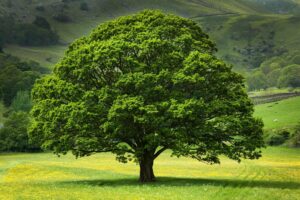Trees are vital to life on Earth, providing oxygen, sequestering carbon, and supporting biodiversity. Over the past 50 years, the global number of trees has seen both significant declines and rises, largely influenced by human activity such as deforestation, urbanization, and reforestation efforts. In 2023, scientists estimated there were approximately 3.04 trillion trees worldwide, a stark contrast to earlier decades. But how did we get here? Let’s explore the changes in tree numbers by decade over the last 50 years, followed by a detailed breakdown of how trees are distributed between forests and residential areas.
Global Tree Count Over the Last 50 Years
Over the past half-century, the number of trees has fluctuated considerably. The data collected from satellite imagery, field surveys, and modeling techniques provide a fascinating overview of these shifts.
The following table summarizes the estimated number of trees globally at the start of each decade, as well as the percentage change from the previous decade:
| Year | Number of Trees (in Trillions) | % Increase from Last Decade |
|---|---|---|
| 1970 | 3.92 | N/A |
| 1980 | 3.70 | -5.61% |
| 1990 | 3.50 | -5.41% |
| 2000 | 3.18 | -9.14% |
| 2010 | 3.04 | -4.40% |
| 2020 | 3.04 | 0% |
1970s: Beginning of a Downward Trend
In the 1970s, the world was home to approximately 3.92 trillion trees. This decade marked the start of a significant decline in global tree numbers, driven largely by increased industrialization and the spread of agriculture. Forests in tropical regions, particularly the Amazon, were rapidly cleared for farming, cattle ranching, and timber production. Although environmental awareness was growing, the overall impact of human activities led to a 5.61% reduction in global tree numbers by the end of the decade.
1980s: Continued Deforestation
By 1980, the number of trees had dropped to 3.70 trillion, continuing the downward trend of the previous decade. Deforestation remained rampant, particularly in developing countries, where forests were often cleared to support economic growth. The rise of palm oil plantations in Southeast Asia and logging in African forests also contributed to the destruction of forested areas. This resulted in another 5.41% decline in tree numbers by 1990.
1990s: Peak Deforestation and Slight Reforestation Efforts
During the 1990s, the number of trees worldwide fell to 3.50 trillion, continuing the trend from previous decades. The 1990s witnessed some of the highest rates of deforestation in history, especially in Brazil, Indonesia, and parts of Central Africa. However, this decade also saw the beginning of reforestation efforts in countries like China and India. These efforts, while promising, were not enough to offset the damage caused by deforestation, resulting in a further 9.14% decrease in global tree count by 2000.
2000s: Slowing Decline
By 2000, the world had 3.18 trillion trees, marking a slowing in the rate of deforestation. Several factors contributed to this, including global awareness campaigns about the importance of forests, stricter regulations on logging in many countries, and the growth of tree-planting initiatives. However, deforestation continued, particularly in tropical regions. Despite these challenges, the decline in tree numbers slowed, with a decrease of 4.40% over the decade.
2010s: Stabilization of Global Tree Numbers
The 2010s saw the global tree count stabilize at 3.04 trillion. Large-scale afforestation and reforestation projects, especially in China, India, and Ethiopia, helped slow deforestation rates. In contrast to earlier decades, where large-scale clear-cutting was common, many countries began to implement policies aimed at sustainable forest management. As a result, the global tree count held steady during this period, marking the first decade since the 1970s without a significant decrease in tree numbers.
2020s: Current Situation
As of 2023, the global number of trees remains at 3.04 trillion. While the decline in tree numbers has halted, the world still faces many challenges in protecting and restoring its forests. Urbanization, infrastructure development, and climate change pose significant threats to forests worldwide, and while afforestation efforts continue, they are often hampered by competing land-use demands. There is hope that continued focus on reforestation and more sustainable forest management practices can help to restore some of the lost forest cover.
How Are Trees Divided Into Residential and Forest Areas?
Trees can be broadly categorized into two main groups based on where they grow: forest trees and residential trees. Forest trees are part of larger, often untouched ecosystems, whereas residential trees are planted or maintained by humans, typically in urban or suburban settings.
Forest Trees
Globally, most trees are concentrated in forest ecosystems. These include:
- Boreal Forests: The largest forested regions in the world, located in Canada, Russia, and Scandinavia.
- Tropical Rainforests: Dense forests found in the Amazon Basin, Congo Basin, and Southeast Asia.
- Temperate Forests: Found in Europe, North America, and East Asia.
- Montane Forests: Forests located in mountainous regions, such as the Himalayas and Andes.
It is estimated that over 80% of the world’s trees are found in forests. These forests provide habitat for countless species and play a crucial role in carbon sequestration and regulating the Earth’s climate.
Residential Trees
Residential or urban trees account for a smaller percentage of the total number of trees, but they are no less important. These trees provide shade, improve air quality, and contribute to the aesthetic and environmental health of cities and towns. Key areas where residential trees are planted include:
- Parks: Urban green spaces and parks are home to millions of trees worldwide.
- Roadsides and Boulevards: Trees are often planted along streets to provide shade and improve air quality.
- Private Gardens and Yards: Many homeowners plant trees in their gardens for beauty and shade.
- Community Projects: Many cities now have tree-planting initiatives to increase their green spaces and mitigate the urban heat island effect.
While urban trees make up a smaller portion of the global tree count, they play a vital role in improving the quality of life for city dwellers.
Which Countries Have the Most Trees?
The number of trees per country varies widely, depending on the size of the country, its climate, and land-use practices. Here are the top countries by tree count:
- Russia: With vast expanses of boreal forest (taiga), Russia is home to the largest number of trees in the world. It is estimated that Russia has around 642 billion trees, making up roughly 21% of the global total.
- Canada: Another country with extensive boreal forests, Canada has approximately 318 billion trees. Most of these trees are concentrated in the northern part of the country, where human activity is minimal.
- Brazil: Brazil’s Amazon Rainforest contains more than 302 billion trees, though deforestation has taken a toll in recent decades. Brazil remains one of the countries with the highest tree count, due to the vast size and density of the Amazon Basin.
- United States: The U.S. has around 228 billion trees, spread across its vast landscape. Forests in the Pacific Northwest, as well as the eastern Appalachian and Great Smoky Mountain regions, contribute to this total.
- China: China has approximately 140 billion trees, largely thanks to the country’s massive reforestation efforts over the past two decades. The Chinese government has made significant strides in combating desertification and expanding its forest cover.
| Country | Estimated Number of Trees |
|---|
| Russia | 642 billion |
| Canada | 318 billion |
| Brazil | 302 billion |
| United States | 228 billion |
| China | 140 billion |
| Democratic Republic of Congo | 101 billion |
| Indonesia | 80.7 billion |
| Australia | 76.7 billion |
| Bolivia | 59.3 billion |
| Mexico | 56.8 billion |
Key Facts About Global Tree Distribution
- The Earth loses approximately 15 billion trees each year due to deforestation, logging, and land-use changes.
- Reforestation efforts are responsible for planting around 5 billion trees annually, which helps to offset some of the losses, though it is not enough to reverse the overall trend.
- About 80% of all trees are found in forests, while the remaining 20% are scattered across agricultural lands, urban areas, and other landscapes.
- According to the World Resources Institute, tropical regions are the most heavily deforested areas, with Brazil and Indonesia being the most affected countries.
Deforestation vs. Reforestation: A Global Balancing Act
Despite the staggering number of trees on Earth, the delicate balance between deforestation and reforestation will determine the future of global tree numbers. While large-scale deforestation in the Amazon and other rainforests continues to be a major concern, there is hope in reforestation efforts.
- Brazil: The Brazilian Amazon has lost over 17% of its forest cover since the 1970s. However, there are also efforts to restore degraded land through programs like the Amazon Sustainable Landscapes Program, which aims to replant millions of trees.
- China: China’s Great Green Wall initiative is one of the largest reforestation projects in history, involving the planting of billions of trees to combat desertification.
- India: India is investing heavily in reforestation through projects such as Mission Green India, which focuses on planting millions of trees to combat climate change and improve air quality.
The Future of Global Tree Numbers
In 2023, the number of trees on Earth remains at 3.04 trillion, a far cry from the 6 trillion trees estimated to have existed before human activity began to significantly alter the landscape. As the world continues to urbanize and develop, the importance of trees in mitigating climate change, preserving biodiversity, and maintaining ecological balance cannot be overstated.
The future of global tree numbers will depend on the actions taken by governments, organizations, and individuals to halt deforestation and prioritize reforestation. The data shows that while we are stabilizing global tree numbers, much work remains to be done to ensure the survival of Earth’s forests and the countless benefits they provide to all living beings.





